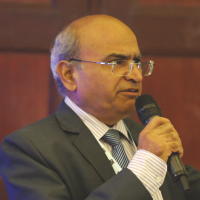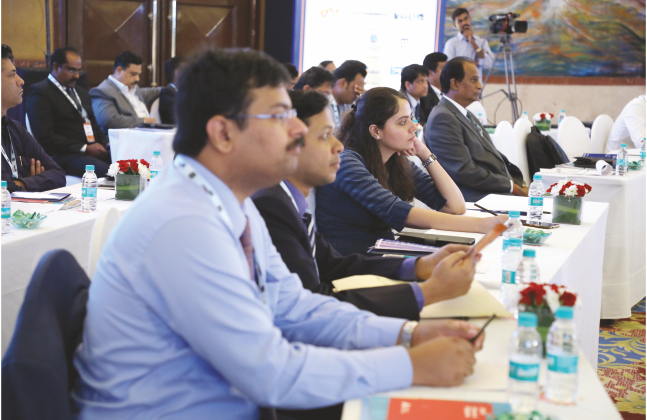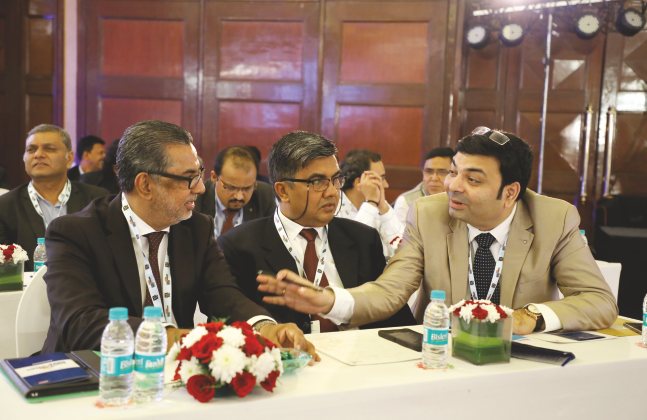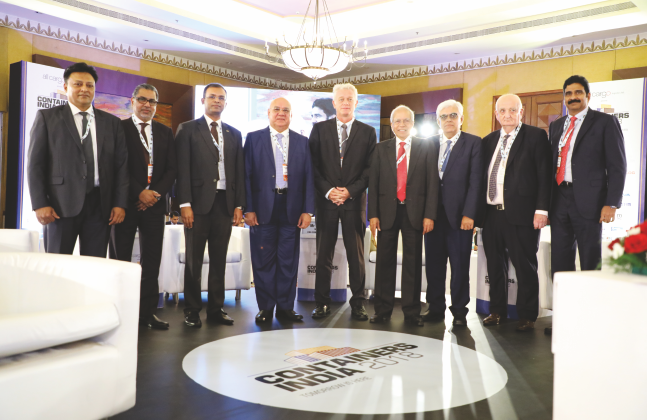A balanced panel of service providers debated on the effects of the lifting of Cabotage and how best can the industry benefit from this new regulatory change
Before getting into the discussions of the session, Moderator Michael Pinto, Former Shipping Secretary, set the direction for the debate to focus on the effects of lifting of Cabotage and how the shippers and service providers can benefit from it. The first question was posed to Capt. Deepak Tewari, Chairman, CSLA.
- What did we really hope to achieve by lifting Cabotage? A probable reason could be to increase transhipment at Indian ports, saving time and money for the trade, while bringing more business to Indian ports which would have otherwise gone to transhipment hubs abroad. If this is the objective will Cabotage alone achieve this or is there something more to be done?
Capt. Deepak Tewari: Cabotage was one of the main issues which has now been resolved. But its not the “end all and be all” in terms of promoting transhipment in India. There are few other issues that need to be tackled. The shipping line has to have options both on the east and west coast for choosing ports that are conducive for transhipment. These particular ports should be in a position to handle not only the larger ships but also a stream of feeder vessels for the aggregation of cargo. They must have the physical infrastructure, productivity norms and they should be able to do this on a 24X7 basis through the contract a shipping company enters into.
The next important thing is the Customs regulations and paperwork. If it is simplified to be done electronically then transhipment works extremely well. The Customs will have to keep up with the general order issued on May 21. The Customs are still not ready with the electronic platform as far as transhipment is concerned.
Julian Michael Bevis: This is a very positive decision in two respects: first, it removes a major obstructer and the secondly, it sends a very strong signal that the government is very keen to undertake reforms in the logistics sector. One area where the costs in India are very high as compared to other transhipment hubs is vessel related costs, marine charges and navigational costs, which needs to be dealt with. It’s not just Customs but certain other regulatory bodies related to transhipment as well who have to facilitate movement of boxes across quays. For example, at Colombo you can send one email and tranship your boxes. We have to be able to do the same thing in India. Whatever regulatory change is implemented it has to be done nationwide and not at select ports.
- After Cabotage relaxation, if regulatory bodies align their operations accordingly, will mother vessels start making a beeline to Indian ports?
Ugo Vincent: Cabotage has definitely improved the movement of cargo across India. It will definitely improve the volumes at ports for those who allow. Calling of vessels will depend on lines bringing imports into India. The volumes of imports will be more guided by the schedule of every liner. The policy change will definitely bring in more ships. In the month of May we were handling 3000 teus and by the end of August we have already reached 30,000 teus. The movement of empty and laden containers is getting more balanced. The shipping community has well understood the benefits of using this Cabotage opportunity and volumes will definitely grow in the days to come.
- How do port operators see Cabotage relaxation as an opportunity? What will they do to encourage more mother vessels to come in?
Anil Yendluri: Our goal was not waiver of Cabotage, but it is to make Indian ports as transhipment hubs, so that our cargo moves through our ports to various parts of the world. This will reduce cost and time making our exporters more competitive and supply chain more effective. While talking about transhipment we found one major obstacle which is Cabotage law that is now removed. But there are several other things to be attended for improving transhipment. Our customers always look for saving on time, cost and ease of doing business. Cabotage relaxation will reduce cost and time factor for trade, but the regulatory bodies such as Customs need to pick up speed which is yet to happen.
Krishnapatnam Port has been doing transhipment volumes in a big way. Of the total volumes handled at the port, 50 per cent are transhipment volumes which is 25000 boxes per month. We are ready to handle both mother and feeder vessels. Our vessel related charges are minimal and waiting time at the port is negligible. But regulatory agencies should also understand and come on-board so that we can improve transhipment volumes at Indian ports.

with the panelists
- Shipping lines may find it difficult to call at a port far away and make it a hub port. Do you see this problem at Krishnapatnam Port?
Anil Yendluri: Not exactly, because when there are adequate volumes especially with India being a big country with origin and destination cargo volumes being huge and if we understand the value of time and money of the liners, I am sure they will call and take the boxes from Indian ports and that is what we are noticing at Krishnapatnam.
- For aggregating feeder cargo what will be the hinterland for Krishnapatnam Port?
Anil Yendluri: We are getting a lot of volumes from Kolkata and Haldia by transhipment to Krishnapatnam and moving out. Certain volumes also come from Paradip and Vizag ports.
- Cabotage was lifted almost 4 years ago for Vallarpadam terminal at Cochin Port but still it has not taken the lead. What ails the terminal?
Jibu Kurien Itty: Cochin Port had the privilege of Cabotage relaxation but we cannot see it in isolation as there were issues with operations of Customs. We had challenges when containers started coming from Chennai because the Chennai Customs was not aware that Cochin Port has got Cabotage relaxation and so they followed the normal export/ import process. Now Cabotage is relaxed across India, but major hindrance we faced at that time was due to the lack of knowledge at other Customs houses.
Another issue is, for example, if you want to send an export container from Chennai to Europe, if it goes to Colombo you get the duty drawback soon after you load on to ship from Chennai. Cochin is actually an SEZ port and if we go by the logic it doesn’t even come under the Indian Territory as far as Customs are concerned. But shipper gets the duty drawback only after the container gets on-board in Cochin. All these hindrances make it difficult for the port to attract shippers. When we talk of bringing back cargo that is being transhipped through foreign ports, we are actually fighting against the transhipment hubs that got established over the past 40 years. It means you are trying to shift the entire network and to accomplish this you need to be one step ahead of the competition. At Cochin Port all the service parameters are well placed but the issue is Cabotage was only relaxed to Cochin and not for other places in India and another drawback is the procedural bottlenecks. If Cochin Port has to attract mainliners it will have to increase its draft, but the port cannot afford the cost and this needs to be funded by the government.
- Prima facie Cabotage seems to save container repositioning cost for shipping lines. Will it be passed on to customers?
Deepak Tewari: The savings in repositioning go to the customer ultimately as it is a matter of negotiation. Customers are fully aware of what are the costs and shipping lines are currently facing a supply-demand situation wherein the customer gets the best freight rates.
Julian Michael Bevis: As a market place becomes more effective and thereby operational costs go down then any service providers, including shipping lines, will compete more intensely and prices will go down. In this scenario the consumers will benefit when the market conditions allow it and savings get passed on.
- How do you see Cabotage Law impacting carriers? Will you change your existing network and enter the Indian feeder market?
Ugo Vincent: first we will have to analyse the added value for importing and exporting from Indian ports. At present we do not have any plans to enter into feeder service.
- If Indian ports improve draft and other infrastructure, will the shipping lines make a long-term commitment to Indian Ports?
Ugo Vincent: We deploy vessels as per supply-demand. We actually use the deployment of exim vessels we have to use Cabotage opportunity.

Julian Michael Bevis: When ports add capacity it gives us more options provided the economics looks sensible then there is a greater chance of the hubing operation being done in India.
- How do you see the lifting of Cabotage benefit Bangladesh cargo?
Mahbubul Anam: Cabotage relaxation does open opportunity for the Bangladesh shipping industry. Our country’s growth has over-run the growth in infrastructure. At this moment the river ports that we have will be greatly benefitted on Cabotage withdrawal. Chittagong Port which is over flooded has long delays on both sides and eastern ports of India could be an ally for us for export and import freight. All we need to do is aligning the India-Bangladesh coastal agreement with what has happened now.
- Can Bangladesh cargo go to East Coast ports? Will it get cooperation from stakeholders from Bangladesh?
Mahbubul Anam: The Customs has been looking after it and I am sure the shipping lines know about it, but what we need to see from the shipping lines perspective is that we would definitely like to see a transhipment port grow in India. At this point we are talking about a double transhipment because it has to come to an Indian port and then get transhipped to a second hub for moving in a mother vessel. We would like to see more aggregation of freight in eastern ports which can cover as a transhipment hub.

- From a shipper perspective, how do you see the lifting of Cabotage?
Dr Siddhartha Rajagopal: We are among the few people putting pressure on the government to relax Cabotage. The raw material for textile industry is available on the west coast and it gets converted on the east coast. Textile business being price sensitive and surviving on thin margins should do everything possible to save on cost and become competitive. Since we are competing with Bangladesh, China and many others, so the logistics component of the cost is looked at and again there is the issue of imbalance in containers at ports. So, this step by the government will to a large extent address these issues.
About 120 lakh bales go to Tamil Nadu which only produces 4 per cent of the cotton, so 2 million tonnes of cotton is received by Tamil Nadu alone. So transhipment can bring us a saving of 5-7 per cent.
- Is there a big difference in marine charges between Indian ports and foreign ports, if so why? Jibu Kurian Itty: Predominantly if you see at all Indian ports, the vessel related charges are pretty high and the container related charges are comparatively low compared to international ports. The reason is that vessel related charges include light house dues, GST and such other elements that increase the charges in India.
Anil Yendluri: We are very flexible and negotiate with our liner partners for fixing tariffs and we are competing with Colombo on that front. We have a parallel arrangement made by Government of India with regard to new airports. To promote calling at new airports the government has come out with a new scheme called ‘UDAAN.’ As per the scheme if a flight lands at a particular new airport, if there are not enough passengers, the money will be reimbursed by the government of India. If we can have similar arrangement for shipping lines, that can induce mainlines to call at Indian ports.
- In India container handling charges are competitive but vessel related charges are high. Is it time for regulatory authorities to intervene and try to bring them down?
Jibu Kurian Itty: Talking about exim cargo, if you really want to compete in international market, the best thing is to have the foreign ships calling our port. Here you need to offer attractive rates to the lines as compared to competition. Once this starts the exim cargo will also be able to save on freight.
Anil Yendluri: On one side we want latest infrastructure for quick turnaround time, but to maintain it is a cost for the port. The port apart from the terminal earns only through vessel related charges. Beyond a certain level the ports cannot offer discounts to liners and here the government should step in to offer discounts.








